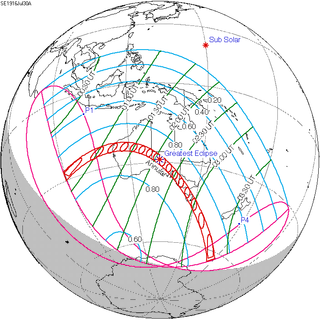
Summary
An annular solar eclipse occurred on July 30, 1916.[1][2] A solar eclipse occurs when the Moon passes between Earth and the Sun, thereby totally or partly obscuring the image of the Sun for a viewer on Earth. An annular solar eclipse occurs when the Moon's apparent diameter is smaller than the Sun's, blocking most of the Sun's light and causing the Sun to look like an annulus (ring). An annular eclipse appears as a partial eclipse over a region of the Earth thousands of kilometres wide. Annularity was visible from only one country, Australia.
| Solar eclipse of July 30, 1916 | |
|---|---|
 | |
 Map | |
| Type of eclipse | |
| Nature | Annular |
| Gamma | −0.7709 |
| Magnitude | 0.9447 |
| Maximum eclipse | |
| Duration | 384 s (6 min 24 s) |
| Coordinates | 29°00′S 132°24′E / 29°S 132.4°E |
| Max. width of band | 313 km (194 mi) |
| Times (UTC) | |
| Greatest eclipse | 2:06:10 |
| References | |
| Saros | 144 (11 of 70) |
| Catalog # (SE5000) | 9318 |
Related eclipses edit
Solar eclipses of 1913–1917 edit
This eclipse is a member of a semester series. An eclipse in a semester series of solar eclipses repeats approximately every 177 days and 4 hours (a semester) at alternating nodes of the Moon's orbit.[3]
| Solar eclipse series sets from 1913 to 1917 | ||||
|---|---|---|---|---|
| Descending node | Ascending node | |||
| 114 | August 31, 1913 Partial |
119 | February 25, 1914 Annular | |
| 124 | August 21, 1914 Total |
129 | February 14, 1915 Annular | |
| 134 | August 10, 1915 Annular |
139 | February 3, 1916 Total | |
| 144 | July 30, 1916 Annular |
149 | January 23, 1917 Partial | |
| 154 | July 19, 1917 Partial | |||
Saros 144 edit
It is a part of Saros cycle 144, repeating every 18 years, 11 days, containing 70 events. The series started with partial solar eclipse on April 11, 1736. It contains annular eclipses from July 7, 1880 through August 27, 2565. There are no total eclipses in the series. The series ends at member 70 as a partial eclipse on May 5, 2980. The longest duration of annularity will be 9 minutes, 52 seconds on December 29, 2168.
| Series members 11–21 occur between 1901 and 2100: | ||
|---|---|---|
| 11 | 12 | 13 |
| Jul 30, 1916 |
Aug 10, 1934 |
Aug 20, 1952 |
| 14 | 15 | 16 |
| Aug 31, 1970 |
Sep 11, 1988 |
Sep 22, 2006 |
| 17 | 18 | 19 |
| Oct 2, 2024 |
Oct 14, 2042 |
Oct 24, 2060 |
| 20 | 21 | |
| Nov 4, 2078 |
Nov 15, 2096 | |
Notes edit
- ^ "ECLIPSE OF THE SUN. A STRIKING SPECTACLE. CROWDS USE SMOKED GLASS. WORK IN OBSERVATORY". The Age. Melbourne, Victoria, Victoria, Australia. 1916-07-31. p. 8. Retrieved 2023-12-02 – via Newspapers.com.
- ^ "SOLAR ECLIPSE. SPLENDID VIEW IN SYDNEY". The Sydney Morning Herald. Sydney, New South Wales, New South Wales, Australia. 1916-07-31. p. 8. Retrieved 2023-12-02 – via Newspapers.com.
- ^ van Gent, R.H. "Solar- and Lunar-Eclipse Predictions from Antiquity to the Present". A Catalogue of Eclipse Cycles. Utrecht University. Retrieved 6 October 2018.
References edit
- Earth visibility chart and eclipse statistics Eclipse Predictions by Fred Espenak, NASA/GSFC
- Google interactive map
- Besselian elements


